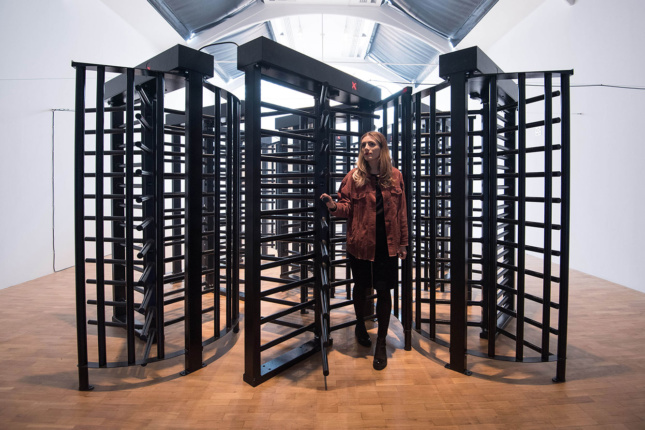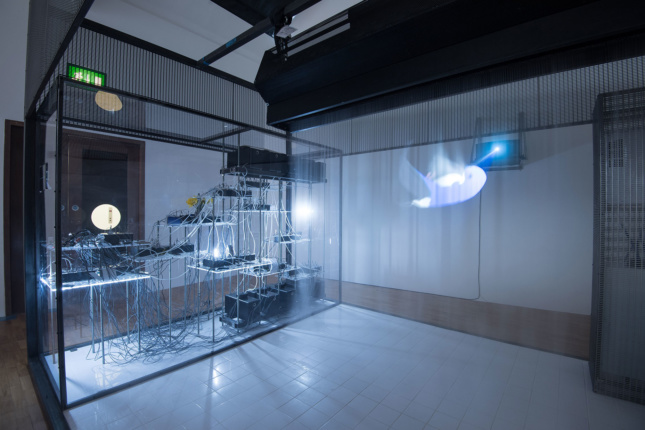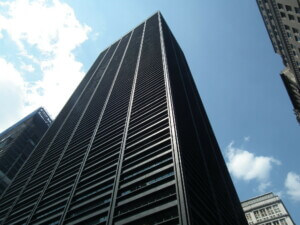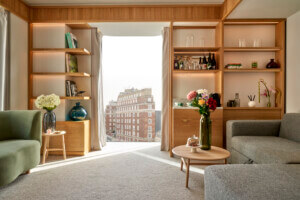Alison and Peter Smithson, James Stirling, Eduardo Paolozzi, and then some: The Whitechapel Gallery’s This is Tomorrow show had an all-star cast when it was unveiled in 1956, not that the audience was necessarily acquainted with these fresh-faced artists and architects (yet). Bold, radical, and surefooted—as the name suggested—This is Tomorrow turned heads as visitors flocked to the then-genuinely edgy East End of London to see the show that was welcoming a new artistic movement, Pop Art, to Britain.
Is This Tomorrow? a show now at the same Whitechapel Gallery in the same, now banker-friendly part of London, recalls the exhibition of 63 years ago. Instead of being laced with new ideas fuelled by the optimism of a country finally free from food rationing, Is This Tomorrow? takes a more pessimistic view of what the future may be.

Ten teams, of mostly architects and artists, have been assembled by curator Lydia Yee. From the start, audiences are confronted by metal sheep pens courtesy of British studio 6a and Argentinian artist Amalia Pica. This is clearly farm equipment and having to move through the narrow contraption in single file as a human is hardly fun, but dark humor punctuates the work; objects like buoys for seals to play with raise questions about how we treat animals. Maybe too, this is how it feels for some in migrant detention camps.
An engaging and provoking start is followed by less moving exhibits on the gallery’s ground floor. Adjaye Associates and Canadian artist Kapwani Kiwanga’s Sankofa Pavilion is meant to be a place for intimate conversations, but the star-shaped installation, which uses dichroic glass to partially reflect light, is more fun for taking pictures in.

Thugz Mansion by London firm APPARATA with Glaswegian artist Hardeep Pandha also falls short. The premise of addressing “what happens to architecture when political systems collapse or become outmoded?” sounds deliciously anarchic but the reality is is that Thugz Mansion lacks any real potency.

The final installation on the large, open ground floor is a welcome return to the dismal yet engaging promise of 6a and Pica’s work. Spirits Roaming the Earth from architect Andrés Jaque and artist Jacolby Satterwhite, both based New York, posits “highendcracy,” while bringing up air-rights dilemmas, designer babies, pollution, fracking, gay porn, queer space, and the placement of 432 Park Avenue renderings in Russian luxury hotels. It’s rich in content and remarkably coherent, even with so much packed in. If you can’t sit through the eight video episodes which explain how the world is fucked by the aforementioned subject matters, a leafy pulsating tower that rises above fumes and a jungle featuring rooms hosting sex parties and topped by two men kissing distills everything nicely.

Above, the second floor is a similarly mixed bag of installations. An interim space glosses over the 1956 exhibition with newsreel footage from the British Pathé archive and an assortment of relevant books. Beyond that, the Mexican match-up of artist Mariana Castillo Deball and Tatiana Bilbao results in what appears to be a melted Mecano set; it’s meant to symbolize communal connections and the Mesoamerican calendar.
Is This Tomorrow? has been promoted alongside a photo of Bait Ur Rouf Mosque in Bangladesh by Marina Tabassum Architects. The firm, with fellow Bangladeshi, artist Rana Begum, has exhibited Phoenix Will Rise—simply an oculus with a crinkled, colored lining, in an inverted trapezoid structure. A weak reference to what is a wonderful building.
Thankfully, two much stronger works follow. Duck down and enter The Salvator Mundi Experience from British duo David Kohn Architects and artist Simon Fujiwara. The work accommodates only one person at a time and offers a 360-degree panorama of 1:24 scale scenes depicting experiences of Leonardo da Vinci’s Salvator Mundi—the painting that broke records when fetching $450 million in New York two years ago. Kohn and Fujiwara’s work investigates the commodification and marketability of art and art experiences, focusing on the public relations campaign from marketing agency Droga5, and depicts an auction room, the Dubai Louvre where da Vinci’s piece was set to be exhibited, a creepy “interactive chapel,” fake replica artwork donation center, a restoration room, and more. All scenes feature CCTV cameras, but of course, the viewer is the real Big Brother.

After these miniature metaphors, Borders/Inclusivity from Iranian-born architect Farshid Moussavi and French artist Zineb Sedira ensnares audiences at human scale (the installation isn’t for those with claustrophobia). Borders/Inclusivity is a procession of turnstiles that turn different ways and force visitors to awkwardly negotiate the course. Meanwhile, motion sensors set off sirens and sounds of border patrol over the radio. The installation is simple but fits nicely with 6a and Pica’s treatment of humans as animals and it’d be a fitting end to the exhibition. However, Brits Rachel Armstrong and Cécile Evans signal the end of Is This Tomorrow? with a piece that somehow dovetails microbial cells and a fog curtain with a fluttering bird projection, all within 140 square feet—London’s smallest living space.
And that’s it. Maybe the Whitechapel Gallery is showing its age—once young and full of hope, now it’s moaning about how bad everything is and how much worse it will get, and not doing it too eloquently either. The original, the emphatic, This Is Tomorrow endures more than half-a-century on; the pessimistic, Is This Tomorrow? might not last so long. Despite offering genuine moments of intrigue and asking tough questions, one leaves wishing it was 1956 again.



















